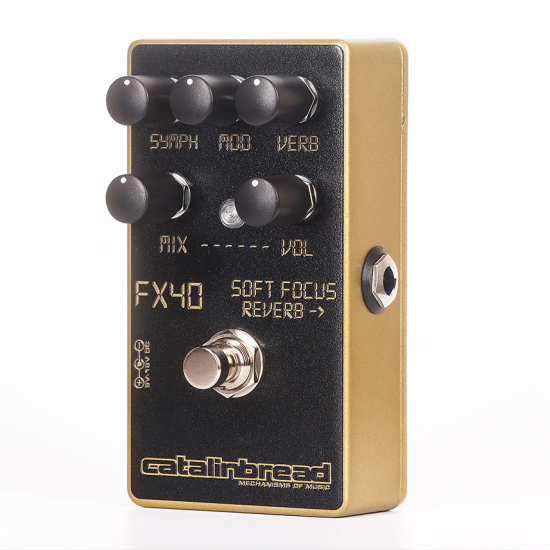







- Stock: Out Of Stock
Hurry, this offer ends in:
The Soft Focus patch on the Yamaha FX500 was widely used in the ‘90s by early shoegaze bands, most notably Slowdive on Souvlaki. With its roots in that patch, the Catalinbread Soft Focus is intended to be an instant shoegaze button, while addressing the most glaring issues of the original unit: no mix control, a sub-par preamp, and a ghastly tone-sucking bypass signal. At its heart, the Soft Focus is a heavily modified plate reverb with adjustable time, which is subsequently split into three paths. One path contains a multi-voiced chorus modulator, another features a well-appointed octave-up mixed in with the reverb, and the third path leaves the reverb untouched. The Mod knob controls the rate of the chorus on path one, and the Symphony knob controls the level of the octave on path two. All controls are "coupled" to the tone of the reverb to give users an expansive playing field of sounds to discover and fine tune. Our Soft Focus is not an exact recreation but was exhaustively
compared with our own FX500; the difference is that a fairly generic fixed-time digital delay is present on the Soft Focus patch. We found that leaving this feature intact ate into the circuit’s memory just a little too much for such little payoff, so we leave that addition to you and your favorite delay.
CONTROLS
SYMPH(SYMPHONY): This knob mixes in a slight octave effect on the wet reverb signal. While subtle, this shifts the mood and character quite a bit. This is also tied to some frequencies in the reverb for more harmonic content.
MIX: This a wet/dry blend. Turn all the up for 100% wet and all the way down for 100% dry.
MOD: This parameter controls the rate of the multi-voiced chorus and changes some of the frequencies in the reverb oscillation.
SF_G_NOBG_LOW.png__PID:1bc1a08b-27ac-4316-a1c2-d9988ee5b42f
VERB: This controls the decay time for the reverb.
VOL: Adds a bit of gain to the dry signal pre effect; can be used when bypassed in buffer/trails mode as a clean boost.
* For full quintessential shoegaze sounds, max all the knobs and adjust the mix to taste. However, every knob is musically interactive with one another for a truly versatile palette usable in a wide variety of styles.
PEDAL PLACEMENT
In short: Put the Soft Focus with your other reverbs, which typically come after your delays.
There are no hard and fast rules with pedal order, because whatever sounds good IS good.
A GOOD STARTING POINT IS:
1. OTHER: Your compressors, filters, synth emulators, pitch shifters and other things like this go here.
2. DIRT: This is your fuzz, distortion, overdrive, etc section. For headroom’s sake, you might want to place pedals that run at higher voltages near the end of this section. Order within this category is not crucial and up to your judgement.
3. MODULATION: This is where your choruses, flangers, vibratos, tremolos, etc go. Modulation pedals notoriously accept very hot signals with ease, including effects loop outputs, so running them after dirt just makes sense. Order within this category is completely subjective, so try different stuff until you dig it.
4. SPATIAL: Spatial pedals include delay and reverb. This is where the Soft Focus could go. Typically, delay comes before reverb because natural reverb occurs after the sound is produced or mechanically within amps, which is typically the last stop for your signal before it hits your ears.
What about reverbs that have modulation like the Soft Focus? We would still put it in category 4, but feel free to experiment until you get the sound you like.
The Soft Focus runs from 9 to 18 volts using a standard DC center-negative power supply for pedals. Make sure you’re using a supply that provides at least 100mA. Running the Soft Focus at 9V will sound great, but if you want a bit more output, a dry signal boost and increased headroom, try any voltage you like up to 18V! The Soft Focus does not run on batteries.
WATCH THE DEMO HERE

